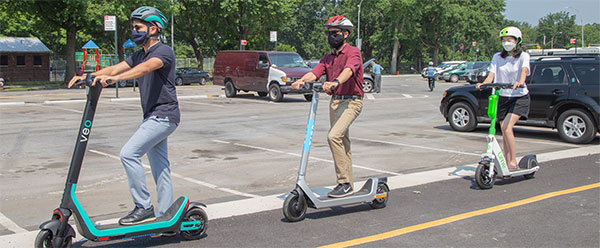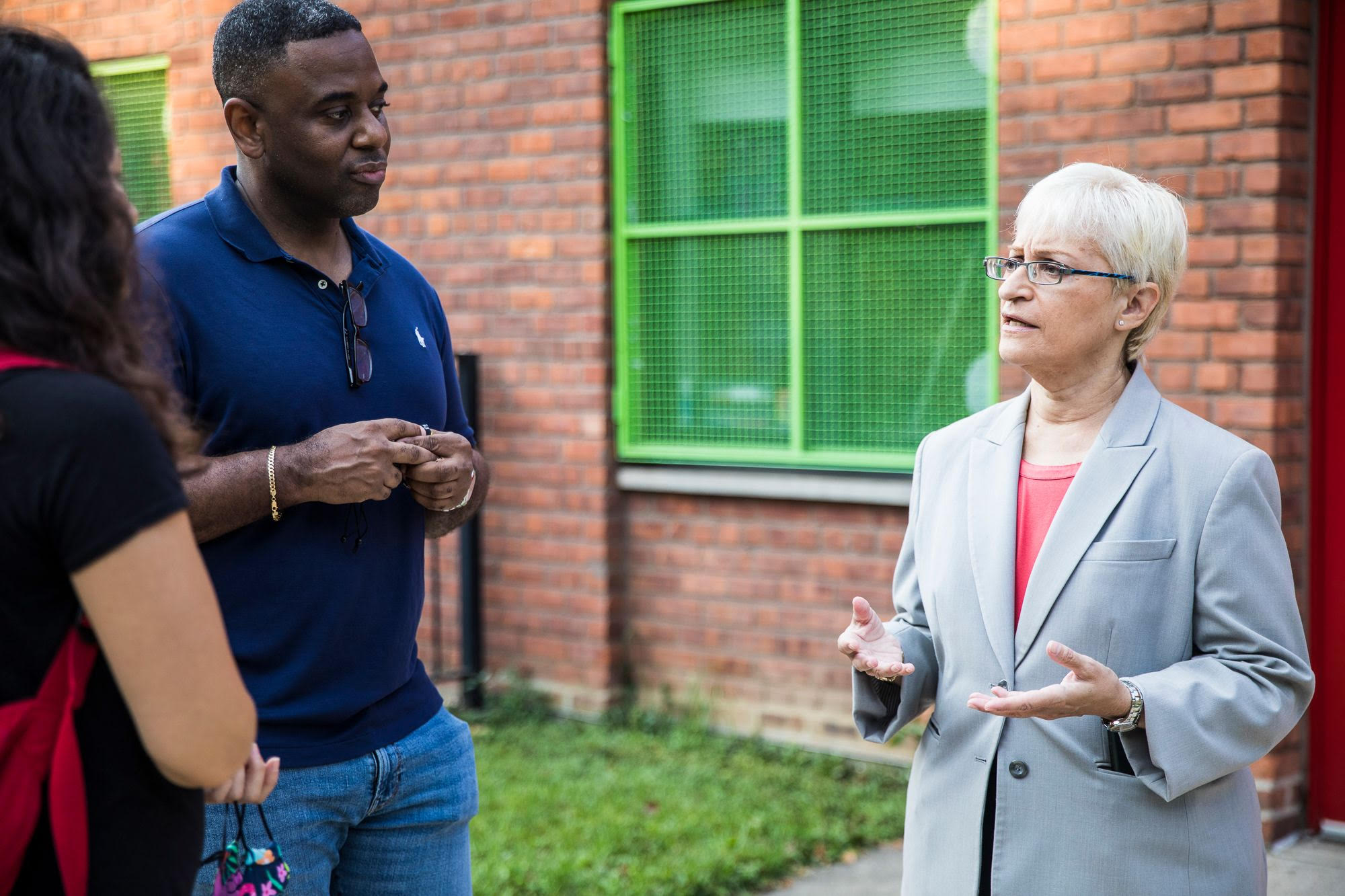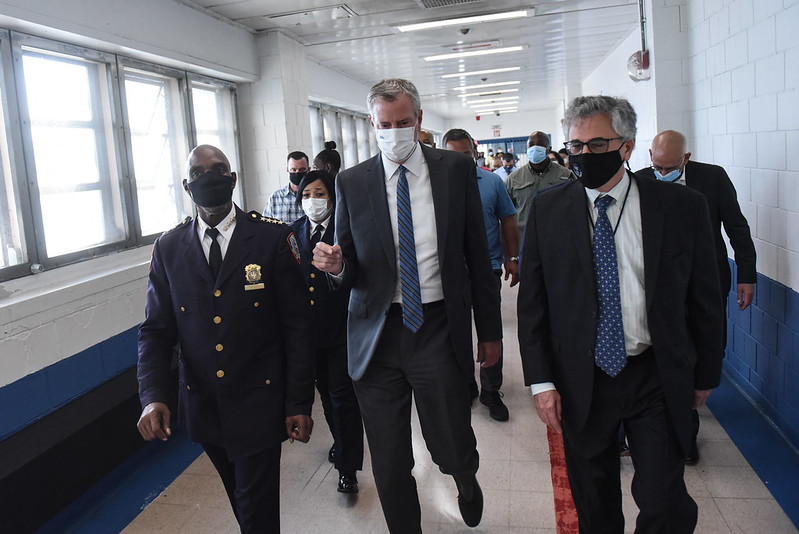The Micromobility Revolution Can Work For Everyone; Here’s How

E-Scooters (photo: NYC DOT)
There’s a revolution going on in the streets of American cities. And it’s driving lots of people crazy.
From coast to coast, in cities large and small, we’re seeing an explosion of new types of electric-powered vehicles. There are e-bikes, of course, including cargo bikes. But there are also electric scooters, electric mopeds, electric skateboards, even electric unicycles. All of these micromobility devices — so called because they are smaller than the humans riding them — represent an exciting new frontier in urban transportation. There are more new vehicles coming to the streets near you very soon, including a variety of electric cargo-delivery bikes and even small, low-speed autonomous vehicles that could be used as taxis or for deliveries.
Clean, quiet, and lightweight, these innovations provide individual users and businesses with the flexibility and freedom of a personal vehicle without subjecting everybody else to the noise and fumes of internal combustion engines. They will be instrumental in meeting the carbon-reduction goals we will all need to embrace in coming years. They also put a lot less wear and tear on our streets and combine easily with public transit, gracefully solving the “last mile problem” that persists in communities around the country.
The only issue is that we don’t really have anywhere for them to go.
E-scooters, e-skateboards, and the like shouldn’t be on sidewalks, where they inconvenience and endanger pedestrians. They also shouldn’t be jockeying for position with trucks, buses, SUVs, and cars in conventional traffic lanes, where their operators are at risk of injury or even death. The obvious place for them to operate is bike lanes — except that the bike lanes we have are too narrow, too unprotected, and too fragmented to make a real transportation network. People who ride traditional bikes are understandably skeptical and nervous about sharing the scant resources they have with vehicles that have electric motors and can travel at higher speeds.
There’s an opportunity here, however, for cities and vehicle manufacturers to partner in creating new facilities that would accommodate a host of small, nimble vehicles, both innovative and traditional. Let’s call them New Mobility Lanes.
New Mobility Lanes would be expanded and enhanced versions of existing bike lanes, designed to accommodate multiple types of relatively slow (10 to 15 miles per hour), lightweight vehicles, including conventional bicycles. Such lanes would be 10 or 11 feet wide, ample to permit safe passing, and protected by physical barriers from incursions by prohibited vehicles. They should extend throughout the city in a robust network that takes users where they want and need to go.
In order for these new lanes to be safe and pleasant for a wide range of users, the types of vehicles that can enter should be regulated. Cities could require limits on heights, weights, and widths; safety features to reduce the risk of collisions with cyclists and pedestrians; and automated data feeds that would monitor and fine illegal maneuvers. Most importantly, so that e-vehicles mix well with conventional bikes, local authorities could mandate speed regulators to ensure that vehicles with electric motors never go faster than, say, 10 to 15 miles per hour. (That limit might frustrate individual users, but any faster would be unsafe in this context, and the resulting order would pay off for everyone in the end.) Geofencing could prevent e-vehicles from driving on the sidewalk. Cities could also determine how much noise such vehicles could make, and require them to be zero-emission.
By expanding the capacity of what have been simply “bike lanes” up until now and building out comprehensive networks of New Mobility Lanes, cities could enlist new constituencies in advocating for their implementation. Drivers understand that trucks are a significant aspect of congestion, so the prospect of moving cargo into small vehicles in a separate lane may appeal to them. Although e-scooters are too new to offer really good data, there is evidence from other cities that they replace car and taxi trips more than they replace cycling trips, suggesting they may draw in yet more users for the new lanes. And the prospect of enclosed, powered, slow-speed vehicles in those lanes could expand their appeal to include many who would never consider themselves cyclists.
In fact, the biggest value of New Mobility Lanes might actually be that they would create a template for the new class of autonomous vehicles that is already coming into being. If AVs are designed to operate on regular streets, cities will have little control over them. But building a widespread network of low-speed lanes with strict specifications on what kind of vehicles can use them would incentivize AV manufacturers to conform to those standards. The result would be mobility innovations that are designed for steady, slow movement rather than speeding and stopping — human-friendly vehicles built to move with the city, not against it.
***
Rohit T. Aggarwala is senior urban tech fellow at Cornell Tech’s Urban Tech Hub. On Twitter @Rit_Aggarwala.
***
Have an op-ed idea or submission for Gotham Gazette? Email This email address is being protected from spambots. You need JavaScript enabled to view it.
My Struggle with Breast Cancer Made Me a Better Candidate

Lynn Schulman, right, the author (photo: Schulman 2021)
Last October, I got scary news. It was during an annual screening (and ironically, during Breast Cancer Awareness Month). At first, I was told there was a suspicious spot and it was probably nothing.
But subsequent tests and procedures revealed that the spot was actually a small, malignant tumor.
I was stunned.
But still, I wasn’t about to let a diagnosis derail my dream of serving my community as an elected official. As any woman will tell you, our success often means keeping our health concerns private — to suffer in silence — so that men do not think we aren’t up for whatever job we pursue.
Breast cancer merged my professional work with my personal life. For decades, I fought to bring health care equity and access to all New Yorkers. That’s been true from my time as an AIDS activist to my recent position on the City Council staff where I have focused on health policy.
And now, as a City Council candidate, health care has been the central focus of my campaign.
I had successful surgery and subsequent radiation treatment, and kept working and campaigning. I am now happy to share that I’m cancer free and just passed my six-month check-up with flying colors.
All things considered, I was lucky because I had health insurance. I was able to get an annual screening and access to treatment from great health-care professionals at every level.
During the COVID-19 era, many women were not as fortunate, pushed to the side as the pandemic overtook our public health resources.
Mammograms were down around 84-90% at the height of the pandemic. Then, when women eventually were able to get their screenings as services were restored, several found out the bill was exorbitant instead of free as it is supposed to be under the Affordable Care Act.
Additionally, during my many medical visits, other breast cancer patients shared that their surgeries were considered elective — meaning they were delayed because of covid protocols. As a result, these poor women were given medications to keep their tumors at bay until their surgeries became more accessible.
Like many women with my type of breast cancer diagnosis, I have to take an aromatase inhibitor, a pill the size of a pin, every day for the next five years, to prevent the cancer from returning. The medication has several side effects, some short-term and some long-term.
For me, they are tolerable. But for a lot of women, the side effects are severe, and many of them choose to risk the possibility of getting cancer rather than alter their quality of life. Not having more treatment options is another deficiency of our health-care system, where money is invested in research that is lucrative, not necessarily life-affirming.
We can’t be caught again in a position where women’s health takes a back seat. That means transforming the citywide health system that makes my experience the one that every woman should expect and have the right to. We need a health-care system that provides equal treatment, especially for women, regardless of who they are or where they live.
Fortunately, the next New York City Council is well-positioned to tackle these issues. In January, the first majority-female Council in history will be sworn in.
It will be incumbent on all of the women Council members to lead and to leverage the unique opportunity we will have as a majority to advance the trajectory of women’s health care — and for our male colleagues to join us. Our health is part and parcel with our city’s ability to thrive.
COVID-19 revealed the serious racial and economic inequities in our city’s health-care system and how isolating the system can be, especially during a pandemic. Our goal must be to make sure each of our city’s neighborhoods have the appropriate health-care and mental health facilities.
So while battling breast cancer wasn’t part of my plan, it was another stark reminder of the constant struggles many women face and what city government should be doing to make our lives better. Life here is already difficult, access to quality health care shouldn’t be an added burden.
***
Lynn Schulman is the Democratic nominee for the New York City Council in Queens’ District 29. On Twitter @Schulman2021.
***
Have an op-ed idea or submission for Gotham Gazette? Email This email address is being protected from spambots. You need JavaScript enabled to view it.
How New York City Ended Mass Incarceration for 30 Days and Could Do It Again

Mayor de Blasio on Rikers Island (photo: Michael Appleton/Mayoral Photography Office)
Just over a year ago, the city of New York did something special, a monumental achievement not seen since the end of World War II. In May of 2020, for the first time since 1946, the average daily population (ADP) of city jails dropped below 4,000.
A combination that included the plan toward a reduced-capacity borough-based jail system, significant bail reform taking accused people’s ability to pay into account, and transitional housing facilities like the ones we at Exodus set up in empty hotels across the boroughs to process people as they were released from city jails, came together to achieve what Mayor Bill de Blasio had just two years earlier said was “noble” but untenable.
This was great news for New Yorkers. Unfortunately, just a month later the population at Rikers Island began creeping up again and now, a year later, swelled to 5,574 people as of October 5.
This is not, like some media and organizations say, due to rising crime - it’s a directly traceable result of a shift away from the policies that made closing Rikers a possibility, back to the policies that in one year have brought Rikers Island to the humanitarian crisis it currently is. After backlash to bail reform by conservative politicians and media, some of the reform measures were rolled back in June 2020 and judges and district attorneys began again detaining people pre-trial indefinitely on Rikers Island. As people and organizations from some communities expressed displeasure at the idea of a correctional facility possibly being built near their neighborhood, the borough-based plan for closing Rikers Island experienced its own backlash. And transitional communities like ours at Exodus continued working with the people who’ve been released while struggling to get the city to commit to issuing vouchers to make it possible for our people to secure permanent housing.
This is all to say, we need to stop, rest, and reassess. New York City was able to significantly reduce the jail population through making serious investments in expanding supervised release, housing, and other alternatives to incarceration that protected vulnerable New Yorkers at the peak of the COVID-19 crisis. With the current crisis in city jails claiming the lives of 14 of our neighbors this year alone, we must renew and increase our investments in these critical programs and the providers who care for our communities.
Two absolute necessities to reclaim our communities are: to have a robust investment in alternatives to detention (ATD’s) and to shift the Department of Correction’s investment toward more programs inside the city correctional facilities, which are sorely needed after 18 months of not being allowed on Rikers Island because of the pandemic.
ATDs provide a higher level of services to people to stabilize their lives and ensure they show up to their court date while diverting them from pretrial detention. Examples of this include Fountain House, which provides services, employment, and educational programs to people living with Serious Mental Illness (SMI). Fountain House reports to have a less than 5% recidivism rate for participants with a history of incarceration and justice involvement.
Over 80% of the women on Rikers Island have a Brad H. designation, meaning they have mental health diagnoses requiring the city to provide special discharge planning services to them. There are still so many women on Rikers Island that we have the resources to provide for outside of jails (or the state prisons where they may be moved temporarily).
Judges must actively start moving to release these people and allow our communities to support this. Exodus recently opened its seventh hotel, located in Downtown Brooklyn, to provide housing for justice-involved New Yorkers, supporting both city and state reentry efforts. The primary goal of community-based hotel housing like ours is to prepare people to transition into permanent housing, challenge discriminatory housing policies, and support impacted communities. We are doing our part in this community task.
Current city Correction Commissioner Vincent Schiraldi has, since assuming the role this summer, made a priority of bringing back educational, vocational, and therapeutic programming to Rikers, fast-tracking the process of obtaining and renewing IDs and working with organizations and coalitions that had a presence there before the pandemic. In the past two months, Exodus staff have been able to navigate services on Rikers Island to ensure people we work with who are being presented for court have access to care packages including essential items they have been denied for much of the past year, such as toilet paper, masks, and hand sanitizer.
We found the way, for those 30 days in April 2020, toward closing Rikers and a post-Rikers way of doing justice and healing communities. Since then we’ve lost our way, and our neighbors are dying in a penal colony that most of us agree should be part of our dark history, not our present. Here are some urgent actions the city must take if we are to find our way back:
Continue to support the Commission on Community Reinvestment established by Local Law 193, and adhere to their recommendations, including baselining in the city budget funding to convene and support the commission through 2027. The Commission on Community Reinvestment was established as a part of the Close Rikers plan but experienced delays because of COVID-19. As of August 2021, the commission had hosted its first town hall and established four subcommittees, led by directly impacted advocates & service providers.
Reduce the DOC workforce to free up to $1 billion per year for community investment to prevent incarceration. This would also allow the Mayor’s Office to shift the administration of services and programming for people in custody away from DOC’s authority to community service providers.
Take steps to proactively meet mental health needs, including stable housing, to prevent people from interacting with the criminal justice system. And support them with permanent housing solutions.
People incarcerated on Rikers Island are our mothers, fathers, sons, daughters, sisters, brothers, cousins, and neighbors. They are our community. And, as a society, we can and must do much better for our loved ones. We can decarcerate to under 4,000 people again and go even further.
***
Kandra Clark is Vice President of Policy and Strategy at Exodus Transitional Community. She oversees Exodus’s policy and advocacy efforts, including supporting the closure of Rikers Island and the transformation of our justice system. On Twitter @KandraClark17 & @etcnyorg.
***
Have an op-ed idea or submission for Gotham Gazette? Email This email address is being protected from spambots. You need JavaScript enabled to view it.




